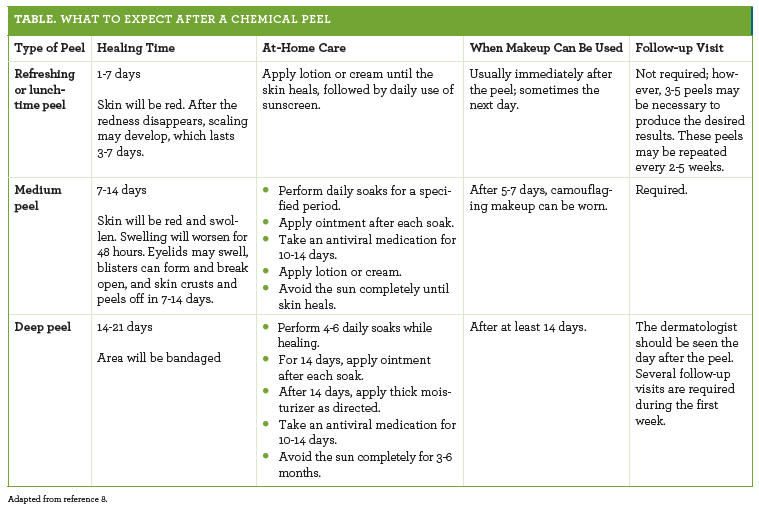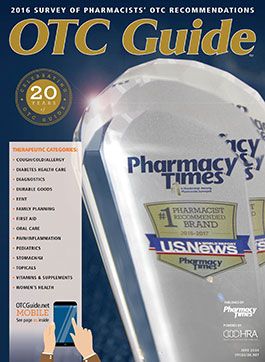Publication
Article
OTC Guide
Acne: The Most Common Skin Disorder
Author(s):
Acne affects 40 to 50 million individuals in the United States.
Acne affects 40 to 50 million individuals in the United States. No wonder it is deemed the most common skin disorder.1 The treatment of acne depends on its severity.
Antibiotics have always been part of the treatment algorithm for acne, but increasing antibiotic resistance may necessitate a different treatment approach.2 To determine the prevalence of antibiotic resistance to Propionibacterium acnes, more than 4000 medical charts were evaluated over a 10-year period. The findings, published in the British Journal of Dermatology in 2002, included the following: the proportion of patients with strains resistant to P. acnes was 34.5% in 1991, 64% in 1997, 50.5% in 1999, and 55.5% in 2000.3 Bacterial resistance to oral antibiotics used in treating acne not only reduces their efficacy against P. acnes but can also lead to resistance from serious bacteria.
As the duration of antibiotic use increases, the chances for antibiotic resistance increases. According to the Global Alliance to Improve Acne Outcomes’ recommendations for the management of acne, published in 2003 and 2009, if a patient shows limited clinical improvement, oral antibiotics should be used for no more than 3 months.2 In addition, according to an article published in the Journal of the American Academy of Dermatology, antibiotic courses 6 months or longer are highly likely to induce bacterial resistance.2
Until recently, only a few published studies investigated the duration of antibiotic use for treating acne. Nagler et al published the following findings in the Journal of the American Academy of Dermatology2:
- The mean duration of antibiotic use in the study population was 331.3 days (range 37-1501 days), with a median of 238 days.
- 21 patients (15.3%) used antibiotics for 3 months or less, whereas 88 patients (64.2%) used antibiotics for 6 months or longer.
- 46 patients (33.6%) were prescribed systemic antibiotics for 1 year or longer
- Minocycline and doxycycline were the top 2 antibiotics prescribed
ISOTRETINOIN
Isotretinoin is approved by the FDA for the treatment of severe acne.1 The drug has been shown to treat acne and provide longterm remission of it,4 but can also be useful in treating less severe acne that is resistant to other treatments.1
Another article published in the Journal of the American Academy of Dermatology supports the use of isotretinoin much sooner in treatment as a way to prevent overuse of antibiotics.2 However, isotretinoin’s role in acne therapy has been limited for many reasons. Not only can isotretinoin cause several serious adverse effects (AEs), it can only be dispensed through the iPLEDGE program.2 Serious AEs of isotretinoin may include the following:
- Depression and increased risk of suicide, although a causal relationship has not been determined.1
- Inflammatory bowel disease (IBD): according to the American Academy of Dermatology (AAD), current evidence is insufficient to confirm a relationship between isotretinoin and IBD. Additional research is needed and may determine whether the risk for IBD is associated with severe acne, not necessarily the treatment.4
- Hepatotoxicity5
- Hyperlipidemia5
Standard isotretinoin must be taken with a fatty meal to optimize absorption, which can be problematic for some patients. If a patient takes standard isotretinoin without a fatty meal, the patient will absorb only about 40% of the dose.4 However, a new isotretinoin formulation offers a better absorption profile and does not require it to be taken with a fatty meal. A patient taking the new formulation can absorb about 70% of the dose without regard to meals.4 Although the cost of the new formulation may be higher, it may be worthwhile for some patients.4
Benefits of High-Dose Isotretinoin
Research results suggest that approximately half of patients who take isotretinoin may have an acne relapse. These patients may require continuous use of isotretinoin or a milder topical or oral acne therapy. Research results suggest that a higher dose of isotretinoin may provide longer-lasting effects.4
Risks of High-Dose Isotretinoin
Higher doses of isotretinoin may increase the chance of AEs, which include dry skin, nosebleeds, inflammation of the lips, hypertriglyceridemia, psychiatric or mood disorders, and temporary worsening of acne.4
CHEMICAL PEELS
With evidence of P. acnes becoming resistant to antibiotics, many health care providers are looking elsewhere for effective treatments. One treatment of high interest is the chemical peel, also known as chemexfoliation. This treatment was once used exclusively to “peel” signs of aging from the skin, but some dermatologists are now using it to treat acne.6
In a chemical peel, a dermatologist applies chemical solutions— such as glycolic acid, trichloroacetic acid, salicylic acid, lactic acid, or carbolic acid (phenol)—to the skin. The dermatologist then removes the peel, leaving the skin with fewer wrinkles and looking smoother.6,7 The 3 types of chemical peels are the refreshing or lunchtime peel, the medium peel, and the deep peel. Regardless of the type of peel performed at a dermatologist’s office, at-home care is required. The Table8 describes what patients should expect after a chemical peel.8

Some patients experience the following AEs from chemical peels8:
- Redness (may last for months)
- Darkening of the skin (temporary)
- Lightening of skin color (can occur with medium and deep peels)
- Scarring (very rare when a peel is performed by a dermatologist)
Chemical peels can cause serious AEs, such as infection and scarring. According to the AAD, serious AEs are more likely to occur if patients do not follow postpeel instructions. To prevent infection or scarring, patients should follow these instructions8:
- Protect the skin from the sun.
- Avoid using a tanning bed or other type of indoor tanning.
- Do not apply makeup until the skin heals.
- Do not rub or scratch skin treated with a chemical peel, as this can lead to an infection.
- Care for a wound as instructed.
According to the AAD, dermatologists recommend the following if patients want to obtain the best results from a chemical peel8:
- Use a moisturizer, as directed by a physician, to prevent the skin from drying and cracking. If the skin dries and cracks, it can scar.
- If the skin burns, itches, or swells, contact the dermatologist.
- After the skin heals, apply sunscreen daily.
Do-it-yourself chemical peels are not recommended because they can increase sun sensitivity, possibly resulting in sunburn. The FDA has issued a statement on alpha hydroxy acids (AHAs), which include glycolic acid and lactic acid, in cosmetic products such as skin peelers. These same chemicals are used in chemical peels.9 According to the FDA Cosmetic Ingredient Review Expert Panel, products containing AHAs are safe for use by consumers if they meet the following criteria9:
- The AHA concentration is 10% or less
- The pH is 3.5 or higher
- The product is formulated in a manner that helps protect the skin from increased sun sensitivity or the package includes directions for daily protection from the sun
CONCLUSION
With the increasing prevalence of antibiotic resistance, changes in the treatment of acne are on the horizon, and they may come sooner than expected. Whether dermatologists will be opting for chemical peels or initiating isotretinoin earlier in treatment, pharmacists need to be prepared for these changes.
Dr. Anyssa Garza received her doctor of pharmacy degree from the University of Texas at Austin. She is currently working as the director of the Life Sciences Library at RxWiki, where she continues to build her practice on the fundamental belief that providing patients with medication information and medical knowledge contributes significantly to the quality of care they receive and improves their quality of life and health outcomes. Her work focuses on educating patients and providing them with the resources needed to navigate the overwhelming and complex health system. Before RxWiki, she was director of pharmacy for a Central Texas Department of Aging and Disability facility.
References
- Titus S, Hodge J. Diagnosis and treatment of acne. Am Fam Physician. 2012;86(8):734-740.
- Nagler AR, Milam EC, Orlow SJ. The use of oral antibiotics before isotretinoin therapy in patients with acne. J Am Acad Dermatol. 2016;74(2):273-279. doi: 10.1016/j.jaad.2015.09.046.
- Coates P, Vyakrnam S, Eady EA, Jones CE, Cove JH, Cunliffe WJ. Prevalence of antibiotic­resistant propionibacteria on the skin of acne patients: 10­year surveillance data and snapshot distribution study. Br J Dermatol. 2002;146(5):840­848.
- Dermatologist evaluates latest isotretinoin developments for treatment of severe acne [news release]. Denver, CO: American Academy of Dermatology; March 17, 2014]. aad.org/stories-and-news/news-releases/dermatologist-evaluates-latest-isotretinoin-developments-for-treatment-of-severe-acne. Accessed November 9, 2015.
- Claravis [package iInsert]. Sellersville, PA: Teva Pharmaceuticals; 2015.
- Chemical peels: overview. American Academy of Dermatology website. aad.org/dermatology-a-to-z/diseases-and-treatments/a---d/chemical-peel. Accessed October 29, 2015.
- Chemical peels and your skin. WebMD website. webmd.com/beauty/peels/cosmetic-procedures-chemical-peel-treatments?page=2. Accessed October 29, 2015.
- Chemical peels: overview. American Academy of Dermatology website. aad.org/dermatology-a-to-z/diseases-and-treatments/a---d/chemical-peel/is-it-right-for-you. Accessed October 29, 2015.
- Alpha hydroxy acids. FDA website. www.fda.gov/Cosmetics/ProductsIngredients/Ingredients/ucm107940.htm. Updated March 24, 2015. Accessed October 29, 2015.







